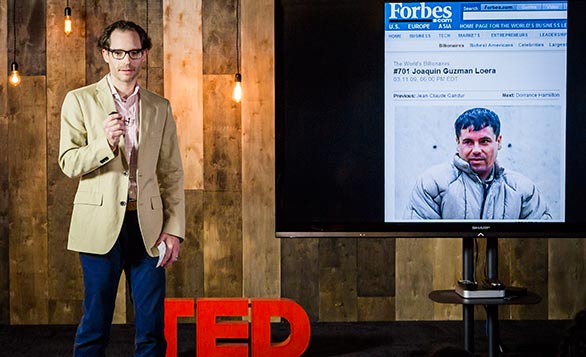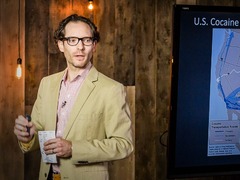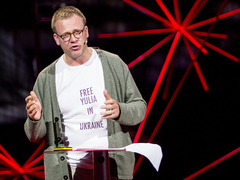
One sign speaker Rodrigo Canales shares that Mexican drug cartels are a big businesses: the CEO of Sinaloa cartel made Forbes’ list of the World’s Most Powerful People. Photo: Ryan Lash
Rodrigo Canales begins today’s talk by bringing us to a very confusing peace march. After a battle between Mexican law enforcement and the drug cartel La Familia Michoacana turned the city of Apatzingán into a battlefield for two days in 2010, the mayor of the town decided to hold a march for peace.
 Rodrigo Canales: The deadly genius of drug cartels
Thousands of citizens showed up. And while half of those at the march wore white and held signs calling for peace, the other half proudly displayed signs and t-shirts supporting La Familia.
Rodrigo Canales: The deadly genius of drug cartels
Thousands of citizens showed up. And while half of those at the march wore white and held signs calling for peace, the other half proudly displayed signs and t-shirts supporting La Familia.
Canales shares this story to illustrate a point: “Our current understanding of drug violence and what leads to it is, at the very least, incomplete,” he says, speaking in the TED office.
Over the past six years, 60,000 to 100,000 Mexicans have lost their lives to drug violence. It’s a staggering number, and one that tends to get tuned out by those reading about it in the United States because of the assumption that those killed are all “bad guys” who are somehow involved in the drug trade. But, as Canales points out, aren’t ordinary U.S. citizens involved in the drug trade too? Currently, there are an estimated 55 million users of illegal drugs in the United States and, together, they make up half of the global demand for illegal substances. The value of the drug market in the United States is estimated in the range of $30 to $150 billion.
Drug violence is not just “goons just shooting each other.” This is big business, says Canales. Drug cartels are incredibly complex organizations that have well-defined structures, that are able to coordinate the movement of supplies from all around the world and that must also guarantee the delivery of their product to the lucrative markets in the United States. (Canales notes: it’s not a coincidence that a map of violence in Mexico matches up almost exactly to a map of the most efficient routes of transportation from the north to the south.) Above that, these violent cartels employ brilliant brand management strategies. To hear the unique brand identities of the big three cartels — Los Zetas, Caballeros Templarios (formerly La Familia) and Sinaloa Federation — and the fascinating ways each approaches the task of recruiting and maintaining high public opinion, watch this eye-opening talk.
“These are sophisticated, coherent organizations that are businesses. Analyzing and treating them as such is a much more useful approach,” says Canales.
Canales’ talk offers a powerful analogy for rethinking our approach to fighting drug violence. And it’s very similar to an idea offered by Jason McCue, who has litigated against terrorists and dictators, at TEDGlobal 2012.
 Jason McCue: Terrorism is a failed brand
In his TED Talk, McCue shared a counterintuitive and underutilized approach to fighting terrorism — to treat it as a brand. In other words: weaken its credibility and reduce its market size.
Jason McCue: Terrorism is a failed brand
In his TED Talk, McCue shared a counterintuitive and underutilized approach to fighting terrorism — to treat it as a brand. In other words: weaken its credibility and reduce its market size.
“What I want us to do [is to] look at terrorism as though it was a global brand, say Coca-Cola,” says McCue. “If you look at it as a brand in those ways, what you’ll come to realize is: it’s a pretty flawed product. It’s bad for your health, it’s bad for those who it affects, and it’s not actually good if you’re a suicide bomber either. It doesn’t actually do what it says on the tin.”
And this, says McCue, is terrorism’s Achilles heel. By getting out there, knocking down terrorism’s brand myth and offering a superior brand — one interested in religious freedom and eradicating poverty — not only will there be fewer terrorist recruits, but fewer people interested in facilitating or financing terrorist operations.
McCue’s idea builds on one that Loretta Napoleoni shared at TEDGlobal 2009 — that barring terrorists’ ability to raise money is key to crippling their destructive power.
 Loretta Napoleoni: The intricate economics of terrorism
Napoleoni is an Italian journalist, who in 1993 was offered the unique opportunity to meet with members of the Red Brigades, a highly secretive Marxist terrorist organization that thrived in Italy from the 1960s through the 1980s.
Loretta Napoleoni: The intricate economics of terrorism
Napoleoni is an Italian journalist, who in 1993 was offered the unique opportunity to meet with members of the Red Brigades, a highly secretive Marxist terrorist organization that thrived in Italy from the 1960s through the 1980s.
“Terrorism is an expensive business,” says Napoleoni, explaining that the grand majority of the members of this organization — and others she has studied since — spent their days raising money rather than plotting or thinking about ideology. “What I discovered is a parallel reality — another international economic system which runs parallel to our own — which has been created by arms organizations since the end of World War II,” she shares.
In this fascinating talk, Napoleoni looks at the growth of this parallel economy, and how it was largely fed by U.S. dollars, often smuggled out of the country through crime and money laundering. She also looks at something very smart that U.S. lawmakers did in the wake of 9-11 to counteract terrorism — that a portion of the Patriot Act addressed finance and gave U.S. officials the right to monitor and investigate transactions. This largely closed the door on money laundering for terrorist purposes. While nefarious activity quickly shifted to Europe, Napoleoni wonders what would happen if this strategy were implemented worldwide.
Even on a regional level, violence adheres to existing social patterns.
 Gary Slutkin: Let's treat violence like a contagious disease
In his TED Talk, physician Gary Slutkin recognizes how — much like the way trade routes in Mexico map onto channels of violence — that gun violence in cities like Chicago spread in patterns that mirror infectious diseases.
Gary Slutkin: Let's treat violence like a contagious disease
In his TED Talk, physician Gary Slutkin recognizes how — much like the way trade routes in Mexico map onto channels of violence — that gun violence in cities like Chicago spread in patterns that mirror infectious diseases.
When Slutkin returned to the U.S. after 10 years of working abroad to stop tuberculosis, cholera and AIDS epidemics, he saw that his own country was also being devastated by its own epidemic — gun violence. Instead of working to contain the contagion, however, it seemed that authorities were focusing their efforts on after-the-fact punishment. Those who acknowledged the causative social forces were too discouraged by the overwhelming challenge of fixing homes, families, schools — in short, everything.
But by using infectious disease transmission as a model, Slutkin was able to put a plan into action: the Cure Violence initiative, which uses community intervention designed to interrupt transmission of gun violence, prevent its further spread and to change cultural norms in the process. So far, it’s been remarkably successful, but also extremely challenging to the way that many had viewed the perpetration of violence. “What do you mean, ‘epidemic?’ What do you mean, ‘no bad guys?’ … What do you mean, ‘hiring people who have backgrounds?’” are among his critics’ concerns, says Slutkin.
Canales, McCue, Napoleoni, Slutkin and others who attempt to reframe our understanding of violence face much of this type of resistance. But their perspectives offer hopeful new paths. Because rather than looking at violence from cartels, terrorists and gangs as inevitable, these thinkers see them as harsh realities that can indeed be rolled back — if we dare to approach them from unexpected angles and leverage the very underlying social structures that drive them.
Morton Bast contributed to this piece.
Comments (15)
Pingback: Картели как бизнес, терроризм как бренд, групповое насилие как эпидемия: 4 речи для переосмысления подхода к борьбе с жестокостью | TED RUS
Pingback: The Role Government Doesn’t Play in Business | SmallCaps.co.za
Pingback: Green is the new red: Will Potter on the problem of treating environmentalists like terrorists | Health & Wellness Chicago
Pingback: My Christmas List for the Utah Legislature | High Resolve
Pingback: TED week, Blog 10 | Let's Get Ethical
Pingback: TED Week- (Blog 10) | B-Ethics